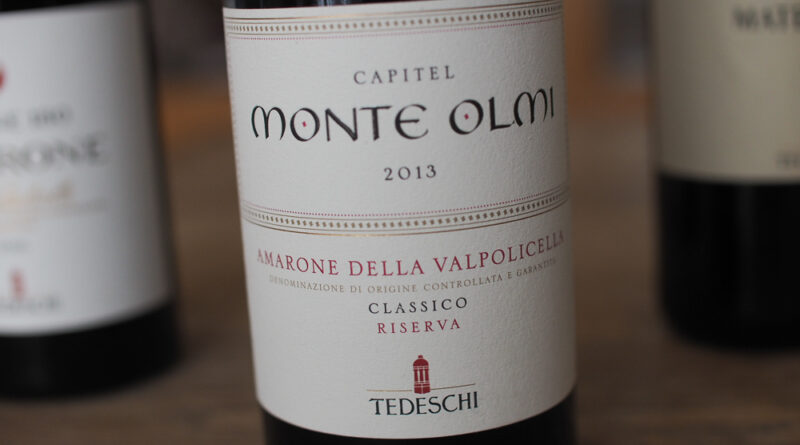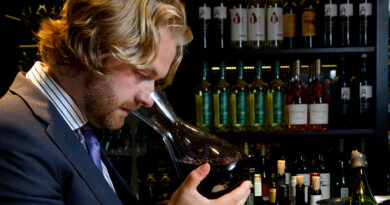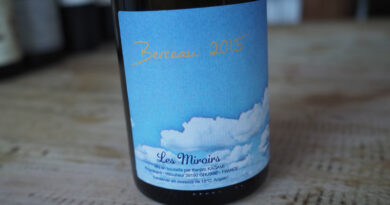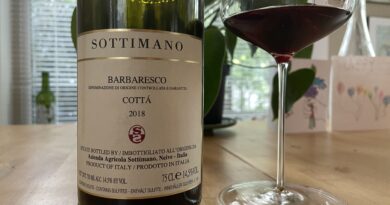Tedeschi: fine wines from Valpolicella, with Sabrina Tedeschi
Tedeschi are one of the historical family-owned producers in the Valpolicella. Over a Zoom call, I caught up with Sabrina Tedeschi to taste some of their wines: a super-Valpolicella and two Amarones.
The current Tedeschi style developed in the 1960s. ‘Or father [Lorenzo Tedeschi] started to focus more on quality production,’ says Sabrina. ‘He introduced the family style. He saw the higher potential of the grapes from the Monte Olmi vineyard and he started to vinify them separately.’ Lorenzo also put the name of the cru on the bottle. ‘It was in 1964. It was one of the first single-vineyard Amarones in the region.’
Tedeschi now own 46 hectares of vineyards, and except for 4 hectares which they use to make an easy-drinking style of Valpolicella, all the vineyards are in the slopes from 200-500 m altitude. ‘We are in the classic, historical area,’ says Sabrina.
In 2005 they bought new land in a special place. The estate is called Maternigo, and it’s in the east of the region between the municipalities of Tregnago and Mezzane di Sotto. This was chosen because of its soil properties, and on the 84 hectare estate there are now 31 hectares of vines planted in 2008, at an altitude between 200 and 450 m. Soils are calcareous with some loam and clay, and they have studied the variation across the property in detail. ‘From a specific parcel in Maternigo [Impervio] we produce the single-vineyard wine Maternigo,’ says Sabrina. ‘We also make Marne 180 Amarone from here, and some other wines.’
We have started a big research project in our vineyards, to get better knowledge of our soils,’ says Sabrina. ‘We started research on terroir and did zoning of our vineyards. After this we did characterization of the soil to understand better the behaviour of the vines in specific soil types.’ Now they are pairing with the biotechnology department at the university of Verona to look at the grape and wine characteristics from each part of the vineyard, looking for the link between flavour and soil. ‘We would like to understand better which flavours are produced in the specific areas,’ explains Sabrina.
The lead researcher on this project is Professor Maurizio Ugliano, and they have looked at five Tedeschi vineyards over three vintages. The goal has been to see whether there is an aroma signature of these vineyards that persists year after year, even on the background of vintage differences. Ugliano says he was expecting to find the differences linked to compounds derived from the grapes, or precursors present in the grapes that were then transformed by yeasts during fermentation. But he has also found aroma signatures that are synthesized directly by the yeasts. It looks like nitrogen in the musts may be affecting yeast performance, and this could be an important way that the vineyard has its effect. ‘We were able to demonstrate that there are certain vineyards – three out of the five we studied – where every vintage is being characterized by a certain type of aroma profile,’ says Ugliano. ‘For example, there is one vineyard that systematically gives more terpenes in the wine than all the others. This is quite tricky to see because the levels of terpenes change with the vintage: there are some vintages that are rich in these compounds, and others less rich, across the board. Then if you look at this from a relative point of view within the same vintage, you find these aroma signatures of the vineyard.’ This research will soon be published.
I asked Sabrina about their preferred style for Amarone. ‘Our style is to make drier wines. We don’t agree with the modern trend to softer styles of wines with some residual sugar. We like dry wines, with good acidity, good tannins.’ They extract at cooler temperatures to avoid extraction of green tannins from the grapes. ‘In the past years we have worked on the drying process, to manage the grapes better. We control temperature and humidity, and we try to maintain the same quality of the grapes from harvest until pressing.’
They dry the grapes in plastic crates, each of which holds around 6 kg. The bunches are first selected in the vineyard, and they are looking for healthy bunches with an open architecture. ‘We dry from the middle of September until December 15 for a part, and then we press some in January.’ So they are dried from 100-120 days. They avoid botrytis as much as they can (some Amarone producers like a bit of botrytis). ‘We work with low humidity: 60% at the beginning. It is very important to control the first 20 days of the drying process. We try to avoid botrytis on our grapes.’
After drying, they destem the grapes and do a long maceration. The fermentation is around two weeks, but the grapes arrive cold (around 5 C, it’s winter), and it takes a while for fermentation to start. The first part is therefore just maceration without fermentation. They like a long maceration after fermentation too: as long as two months. Sometimes pressing is as late as April.
After pressing they keep the wine in stainless steel tanks for a few months, and then go to large barrels of 1000-5000 litres. ‘The Marne is aged for three years, and Monte Almi is aged for four years in barrels,’ says Sabrina. ‘We don’t use small barrels because we like to reduce the wood character in the wines. It was a bad trend in the past. We prefer to explain better the terroir and the character of our varieties.’
THE WINES
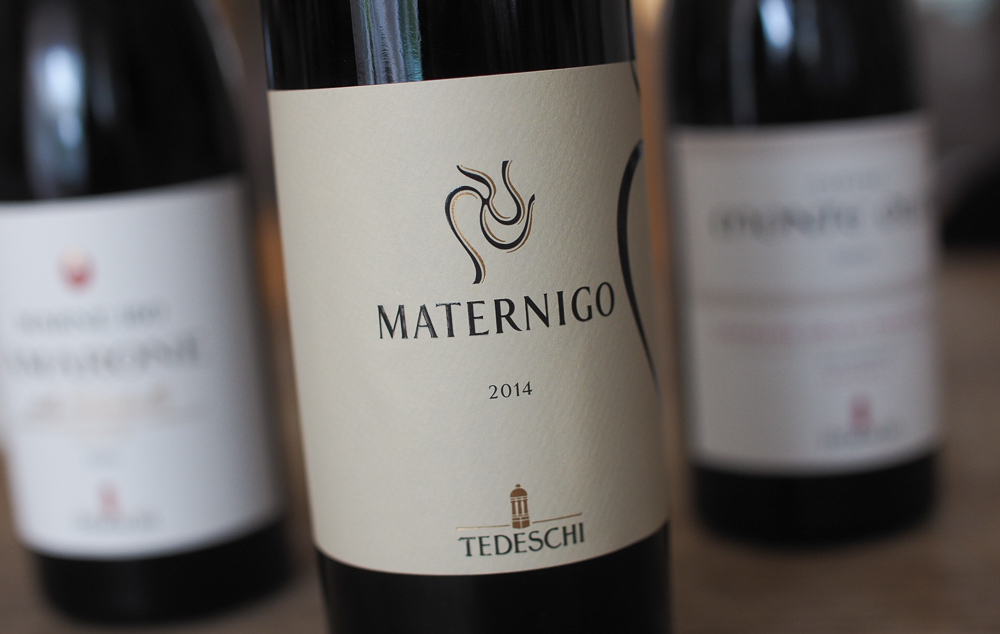
Tedeschi Maternigo 2014 Valpolicella, Italy
14.5% alcohol. 2011 was the first vintage for this wine. 2014 was a cool, rain-affected vintage, but this vineyard is in the hills in the east of the region, so it can handle rainy vintages better than the flat areas. The three grapes, from a single parcel, were harvested a little over-ripe. Soils here are colluvial, with limestone and clay. It is quite a shallow soil, and this part is quite white and rocky. Yields just under 8 tons/hectare. Long maceration of almost a month. 18 months in large barrels (1000-5000 litres). Lovely density here with some pepper and black cherry notes as well as plums and spice. Complex with hints of leather and iodine, and some warm spiciness on the finish. Lovely density: a rich wine but with complexity. Has some chocolatey richness. 92/100
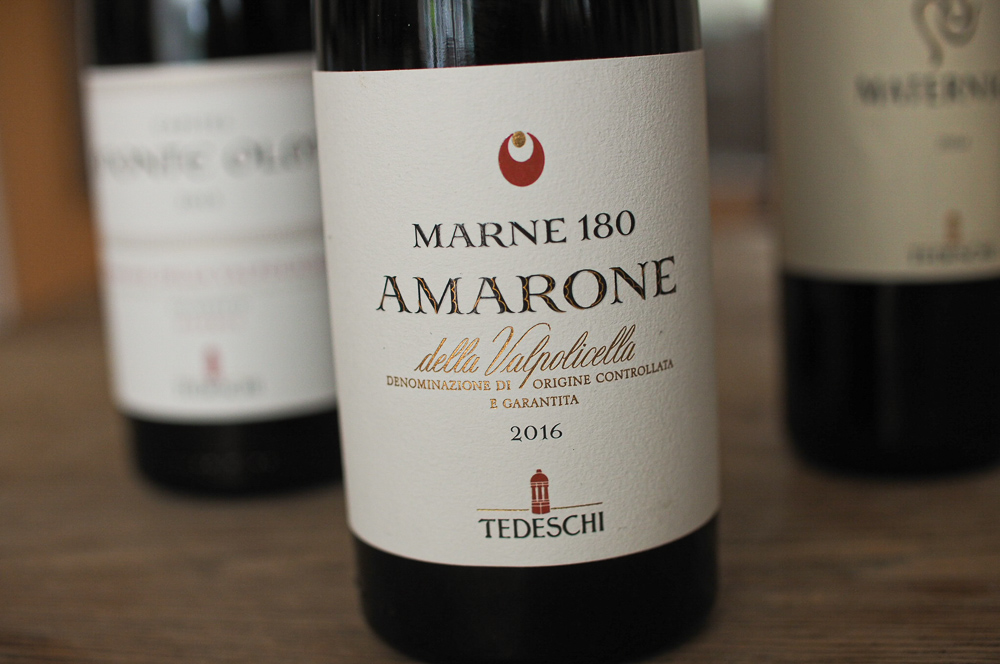
Tedeschi Marne 180 Amarone della Valpolicella 2016
16.5% alcohol. This is quite lovely. It has appealing aromatics with fresh red berries and cherries, with some floral character, and a hint of leather. There is lovely fruit purity and intensity. The palate is fresh and focused with lovely pure red fruits, and a silky mid-palate with a dry character, showing some softness and complexity. There’s some tea and herb complexity under the silky, fresh fruit, with lovely focus and finesse. Quite beguiling with lovely purity and elegance, and sheer drinkability. The alcohol is carried very well. Sensational wine. 95/100
Tedeschi Capitel Monte Olmi Amarone della Valpolicella Classico Riserva 2013
17% alcohol. Terraced vineyards, with marl (limestone with clay), very poor in nutrients. There’s some minty freshness on the nose with pepper and raspberry, cherry and plum. Quite seductive and aromatic. The palate is powerful, but retains elegance with good balance despite the 17% alcohol. There’s a lovely freshness to the fruit that balances out the richness, and the result is a complex, focused wine with great complexity, showing some herbs, spice, tea and a hint of tar. This is a special Amarone. 96/100
UK agent: Fells
Find these wines with wine-searcher.com

